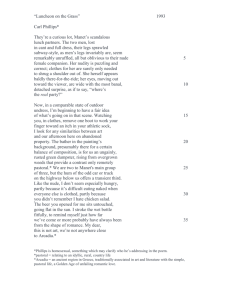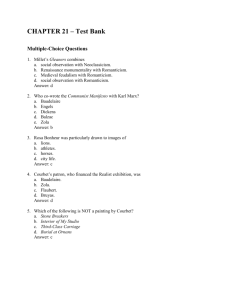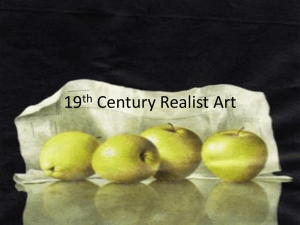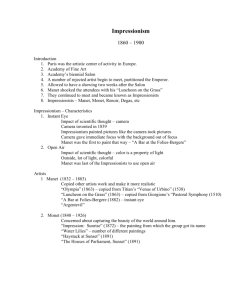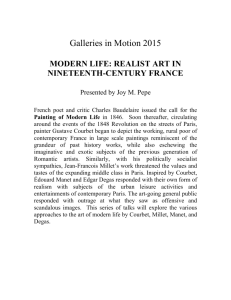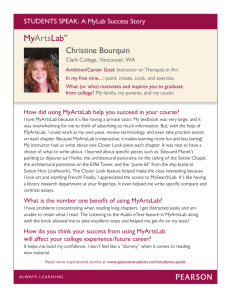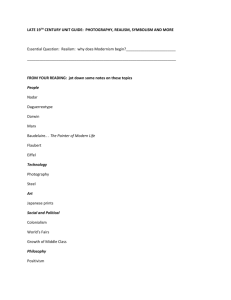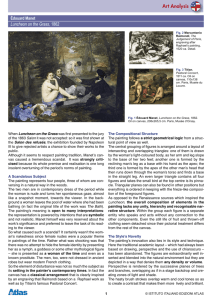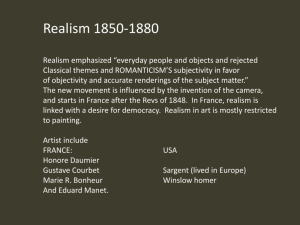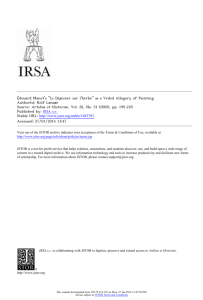modern art - Verlagsgruppe Random House
advertisement
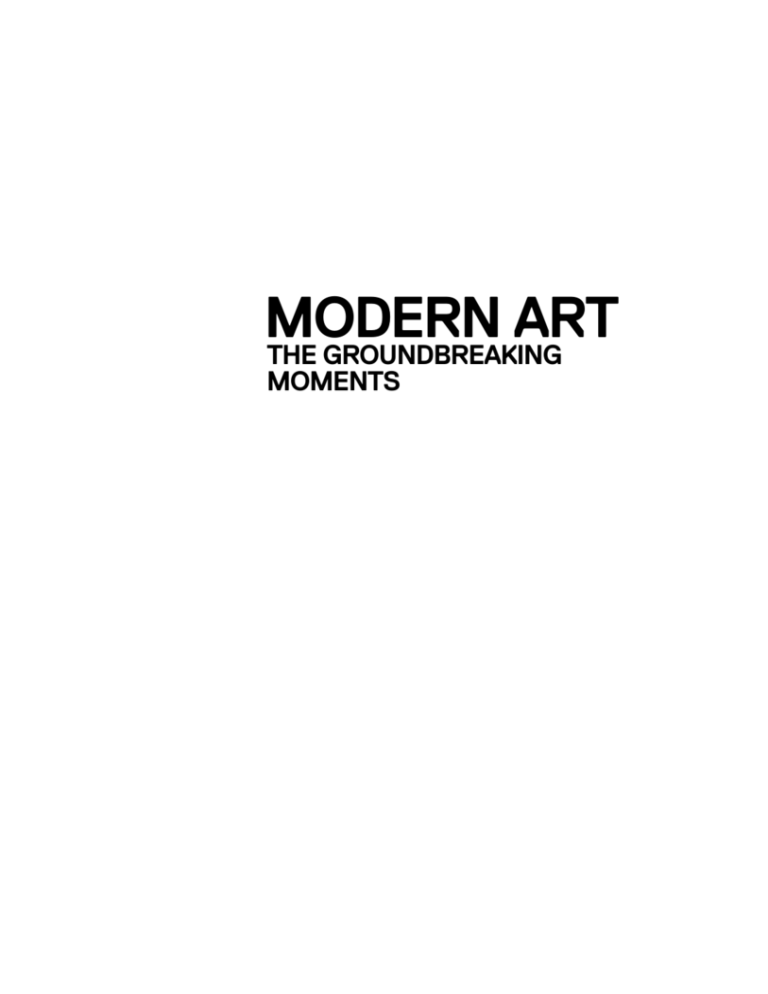
MODERN ART THE GROUNDBREAKING MOMENTS MODERN ART THE GROUNDBREAKING MOMENTS BRAD FINGER PRESTEL Munich ∙ London ∙ New York Manet Monet Cézanne Van Gogh Rodin Matisse Picasso Malevich Kandinsky Duchamp Ernst Kirchner Rivera Calder Pollock Riley Hamilton Klein Dubuffet Paik Close Smithson CONTENTS 6 Introduction 8 Édouard Manet: Le déjeuner sur l’herbe Claude Monet: The Birth of Impressionism Paul Cézanne: The Artistic Process Vincent van Gogh: Wheatfield with Crows Auguste Rodin: Balzac Henri Matisse: The Harmony of Fauvism Pablo Picasso: Les Demoiselles d’Avignon Kazimir Malevich: The Cosmic Art of Suprematism Wassily Kandinsky: Abstract Art Marcel Duchamp: Art Redefined Max Ernst: The Surrealist Melting Pot Ernst Ludwig Kirchner: Die Brücke and Expressionism Diego Rivera: The Court of the Fiestas and Modern Political Art Alexander Calder: Kinetic Art and the Contemporary Museum Jackson Pollock: Abstract Expressionism and the Cultural Rebel Bridget Riley: Op Art Richard Hamilton: Pop Art and Commercial Society Yves Klein: The Immaterial Jean Dubuffet: Art Brut and the Outsider Artist Nam June Paik: TV Cello and the Multimedia Revolution Chuck Close: Photorealism Robert Smithson: Spiral Jetty and the Art of Entropy 16 26 36 46 54 62 70 80 88 96 106 116 124 134 142 152 158 164 170 176 182 188 189 190 192 List of Artists Selected Bibliography Index Photo Credits | Imprint INTRODUCTION The nineteenth century ushered in an unprecedented era of change. The spread of modern industry, the rapid growth of cities, and the dramatic advances in transportation and mass media inspired radically new artworks. Modern Art: The Groundbreaking Moments discusses the key pioneering efforts of this art, starting with Édouard Manet’s Le déjeuner sur l’herbe (The Luncheon on the Grass). Manet’s provocative work was shown at the 1863 Salon des Refusés in Paris, the first great exhibition of avant-garde painting. From such beginnings, modern artists developed an abundance of movements and styles. Further chapters examine Claude Monet’s Impression, Sunrise, one of the first Impressionst paintings; Wassily Kandinsky’s Composition VII, an early work of abstract art; and Richard Hamilton’s Just what is it that makes today’s homes so different, so appealing?, a founding image of Pop Art. Each one discusses why the artists produced their works—touching upon their chief sources of inspiration and their innovative art-making techniques. The chapter on the video art of Nam June Paik assesses the ways in which the art- left—Ernst Ludwig Kirchner, Female Artist (Marcella) 1910 | oil on canvas | 100 × 76 cm | Brücke-Museum | Berlin. ist was responsive to advances in technology. Other chapters explain the effect of political upheaval on artists, including the revolutionary muralist Diego Rivera, or show how others were merely seeking to create their own personal niche in the art world, such as the Op artist Bridget Riley and the Photorealist Chuck Close. Modern Art: The Groundbreaking Moments will also discuss how its featured artworks inspired later generations and movements. Vincent van Gogh’s passionate Wheatfield with Crows from 1890 profoundly influenced the work of German Expressionism in the 1910s and 1920s. Paul Cézanne’s Mont Sainte-Victoire stimulated the geometrical explosiveness of Cubism. And Marcel Duchamp’s readymades, including his Fountain, inspired a remarkable variety of postmodern conceptual art and performance art as well as outraging many critics at the time. As this book will show, the history of modern art has always been a process of dynamic cultural exchange; a process that since World War II has become increasingly diverse and multicultural. The stirrings of modernism that began in Paris have now spread to China, Latin America, and around the world. The twenty-two chapters of Modern Art: The Groundbreaking Moments, present a small but influential sampling of that diversity. ................. 1815: Congress of Vienna .......................................... 1819: Carlsbad Decrees ........................................................................................................................................................... ................................................. 1817: Wartburg Festival................................................................................................................................................................................................................. 8/9 ........................................................................................................................................................................... 1826: First photographs ......................................................................................................... 1819 – 1877: Gustave Courbet 1830 – 1903: Camille Pissarro 1832 – 1883: Édouard Manet ÉDOUARD MANET: LE DÉJEUNER SUR L’HERBE The nineteenth century was an age of radical transformation. Technological progress was becoming a central feature of Western culture, changing the way people lived, worked, and interacted with one another. New industrial marvels were being developed with startling regularity: the steam engine, the telegraph, the mechanical reaper, and the photograph. All of them had dramatic consequences for the lives of ordinary people, leading many to move from small towns to cities, from farm life to industrial careers. Paris was one of many Western cities whose population had boomed. By the 1850s, Parisian city planners were conducting the world’s most audacious program of urban renewal. Under the direction of Baron Georges-Eugène Haussmann, overcrowded medieval districts were torn down and replaced by wide boulevards and grand apartments. Royal hunting grounds, including the Bois de Boulogne, were turned into landscaped city parks; and huge train stations, such as the Gare de Lyon and the Gare du Nord, were built or reconstructed. One of the most left—Édouard Manet, Le déjeuner sur l’herbe | detail. right—Édouard Manet, Le déjeuner sur l’herbe | 1862/63 oil on canvas | 208 × 265.5 cm | Musée d’Orsay | Paris. spectacular of these urban projects was centered around the Louvre museum, which had only been open to the public for a few decades. The monumental Rue de Rivoli provided a grand thoroughfare connecting the Tuileries Garden and the museum, enhancing the Louvre’s new role as a “modern” tourist attraction. Édouard Manet (1832–83) was a key figure in Paris’s cultural revolution. Born into a wealthy family of diplomats and judges, he rebelled against the legal career his father had desired for him. In 1850, Manet 10 /11 MANET ..................................................... 1848: Revolutions in Europe .................................................. 1853-1856: Crimean War................................................................................. ....................................................................................................................... 1849: Death of Chopin .................................................................................................................................... ................................................................................................................................................................................................................................ 1857-1859: First world economic crisis............................ 1840 – 1926: Claude Monet 1841 – 1919: Auguste Renoir 1853 – 1890: Vincent van Gogh » Like Le déjeuner, Courbet’s L’atelier du peintre places a vaguely classical nude within a contemporary scene; Courbet’s work, however, has an overtly allegorical function.« began his artistic studies under Thomas Couture (1815–79), one of the more inventive painters and teachers of the day. Couture’s own works are often characterized by bold brushstrokes and a precise understanding of light and shade. In his writings, Couture promoted the use of modern subjects in art, saying: “I did not make you study the old masters so that you would always follow trodden paths. Those lessons were indispensable to give you fluency in the language. Now that you possess it, speak; but speak in order to relate to your own times. Why this antipathy for our land, our customs, our modern inventions? … You say, ‘But the ancients never did anything like that?’ For the very good reason that such things did not exist.” Manet’s own paintings would absorb Couture’s interest in modern themes. They would also benefit from the rich diversity of mid-nineteenth-century Parisian art, from the passionate color and brushwork of Eugène Delacroix (1798–1863) to the stark, aggressive realism of Gustave Courbet (1819–77). And like nearly all Parisian art students, the young Manet would spend hours in the Louvre, analyzing and copying its vast assemblage of old master paintings—works by Raphael, Diego Velazquez, the Le Nain brothers, Peter Paul Rubens, Antoine Watteau, Francisco de Goya, and Jean-Baptiste-Siméon Chardin. These studies were supplemented by extensive travel throughout Europe, where he viewed collections in Germany, Austria-Hungary, the Netherlands, and Italy. Manet soon acquired an encyclopedic knowledge of Western art history. When he left Couture’s studio in 1856, he began to develop a style that boldly combined pictorial elements of old and modern masters with the “vernacular” imagery of his rapidly changing city. In 1863, Manet produced several paintings for the Paris Salon. This “official” exhibition of new works was organized by the city’s leading art school, the Académie des Beaux-Arts. But Manet had never studied at the school, and the paintings he submitted were rejected by the straight-laced jury of Académie members. Many other artists suffered the same fate that year, as the jury rejected more than half of the submitted paintings, a decision that drew the ire of artists and art critics alike. Press coverage of the 1863 Salon was often scathing, and it prompted the French government to sponsor their own event to “let the public judge the legitimacy of these complaints” and to view the “rejected works of art” for themselves. The new exhibition was called the Salon des Refusés (“Exhibition of Rejects”), and it received an unprecedented amount of publicity. Manet’s own art garnered much of the critical attention. For many skeptical viewers, his works seemed unpolished and needlessly provocative. The one painting that caused the most stir among critics and the public was Le déjeuner sur l’herbe (The Luncheon on the Grass) (fig. pp. 8/9). In Le déjeuner, Manet placed a nude female figure in the middle of a bizarre picnic scene. The woman sits next to two fully clothed, middle-class Parisian right— Gustave Courbet, L’Atelier du peintre | 1855 oil on canvas | 361 × 598 cm | Musée d’Orsay | Paris. gentlemen; her garishly lit body stands out against the men’s dark clothing and the surrounding forest. The female nude had long been a favorite subject for artists, and Manet’s woman adopts a pose based on Renaissance-era depictions of Venus. But the placement of such a figure in the “modern world,” alongside clothed men, offended many viewers. And though the woman’s reclining posture resembled that of a Renaissance goddess, her skin and face were painted with a sharp naturalism; her nonchalant gaze focused directly at the viewer. Other aspects of Manet’s technique also provoked critical comment. The spatial relationship between the figures in the foreground and the reclining woman behind was unnatural, giving the landscape a disorienting, flat appearance—like a warped stage set. This unnatural look was heightened by the artist’s loose, free brushwork. One can compare Le déjeuner with a slightly older work by Gustave Courbet. As the leading artist of France’s Realist movement, Courbet had sought to highlight the gritty, sometimes prurient aspects of modern life. Like Le déjeuner, Courbet’s L’atelier du peintre (The Painter’s Studio) (1855) (fig. above) places a vaguely classical nude within a contemporary scene; Courbet’s work, however, has an overtly allegorical function, as its subtitle indicates: “A Real Allegory of a Seven Year Phase in my Artistic and Moral Life.” The female nude is clearly defined as an artist’s model, and her nakedness is partially veiled by the robe she holds in her hands and by a demure facial expression that is turned away from the viewer and toward the painter at work. For Courbet, the model is merely one figure amidst a group of characters—beggars, wealthy businessmen, and exotic foreigners—that represent the ideas and social themes that he was exploring as an artist. The Realist master also incorporates traditional techniques, including rich, three-dimensional modeling; somber, earthy colors; and fine detail. For nineteenth-century Parisians, the style and content of L’atelier du peintre was relatively familiar. By comparison, Manet’s later picture seemed to provoke the viewer in disturbing, enigmatic ways. Though the publicity surrounding Le déjeuner was initially critical, Manet’s painting would soon become an iconic image for many younger artists. Claude Monet (1840–1926), Pierre-Auguste Renoir UNVERKÄUFLICHE LESEPROBE Brad Finger Modern Art: Groundbreaking Moments Paperback, Flexobroschur, 192 Seiten, 19,3x24,0 160 farbige Abbildungen ISBN: 978-3-7913-4721-9 Prestel Erscheinungstermin: November 2012
